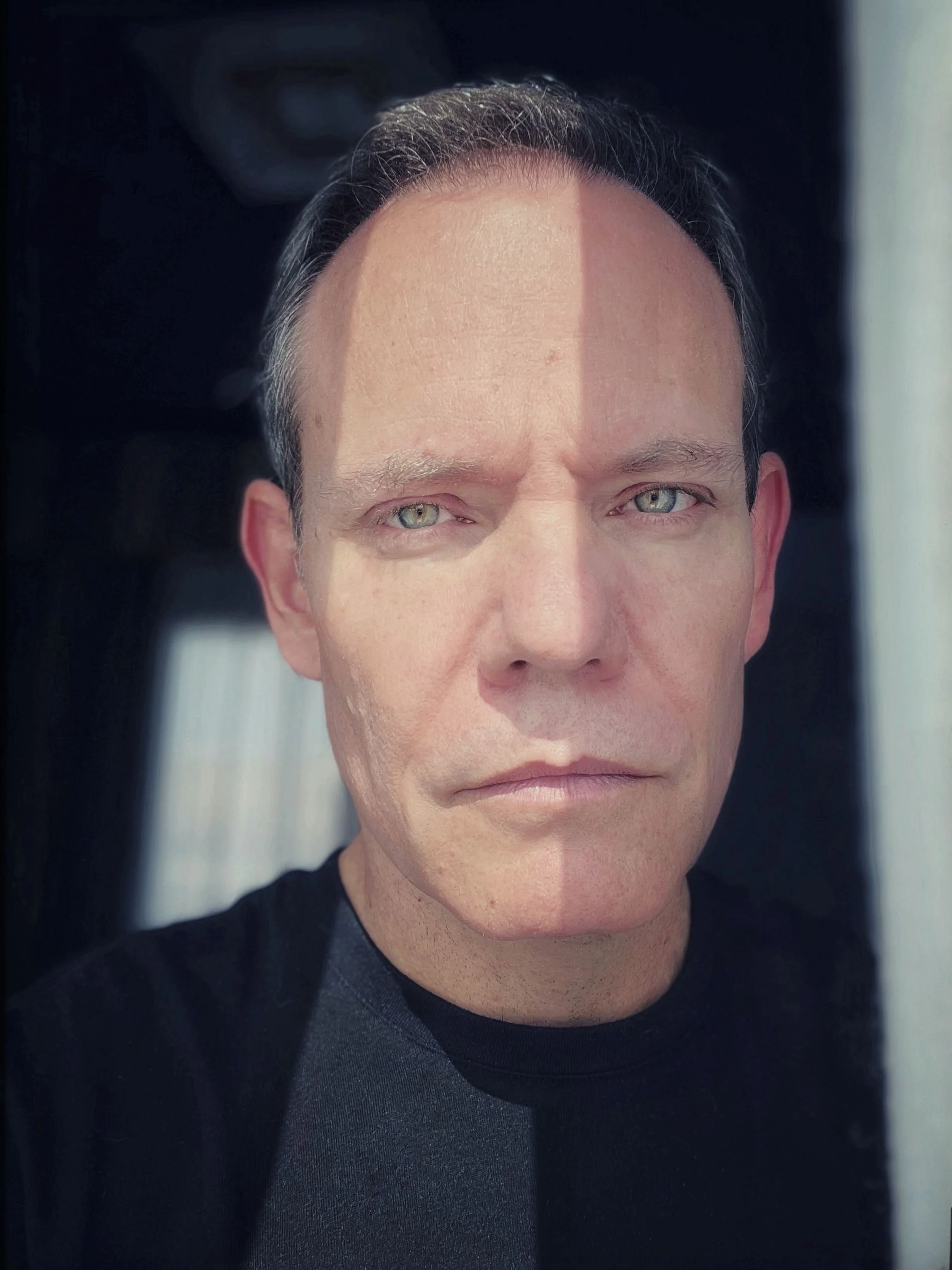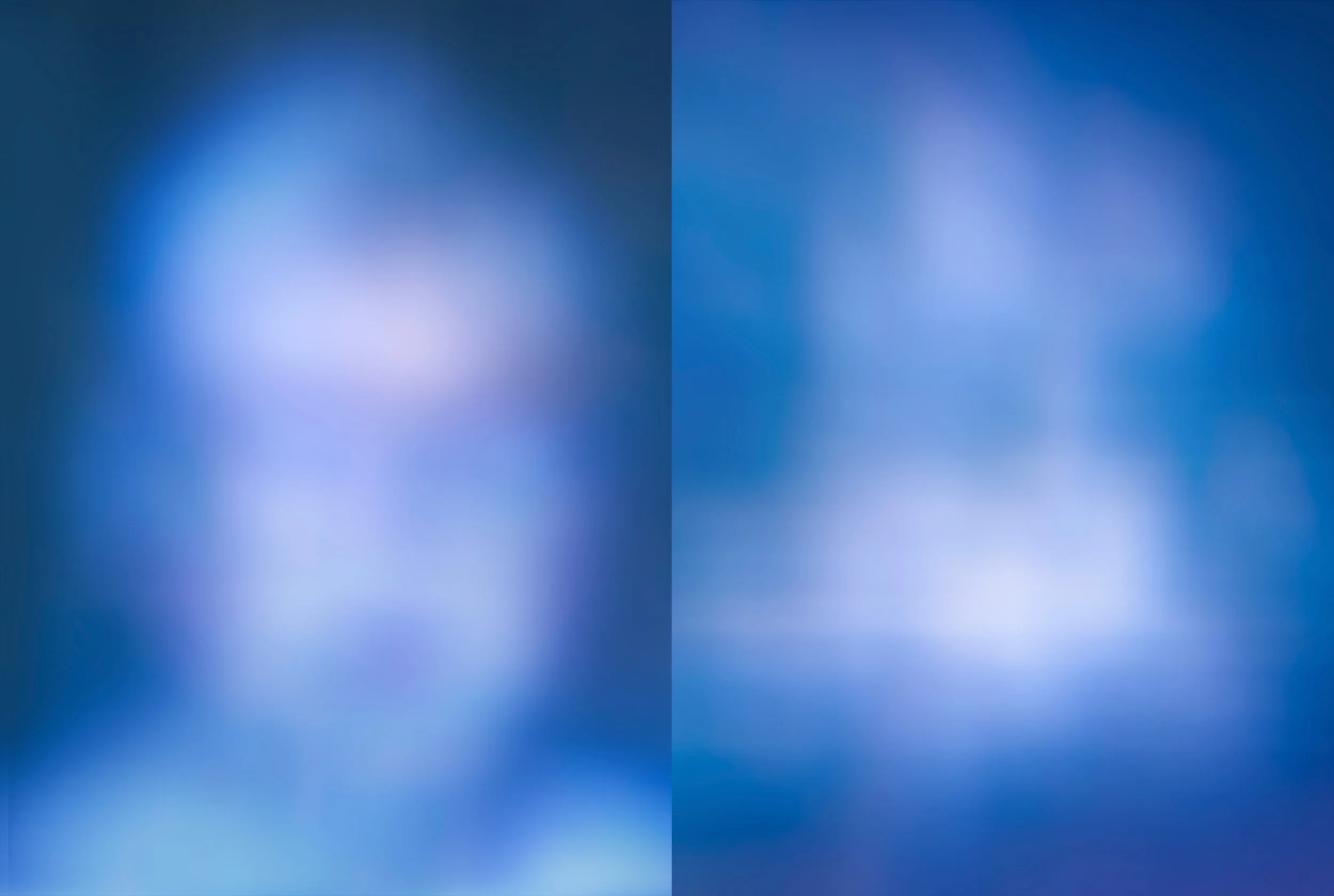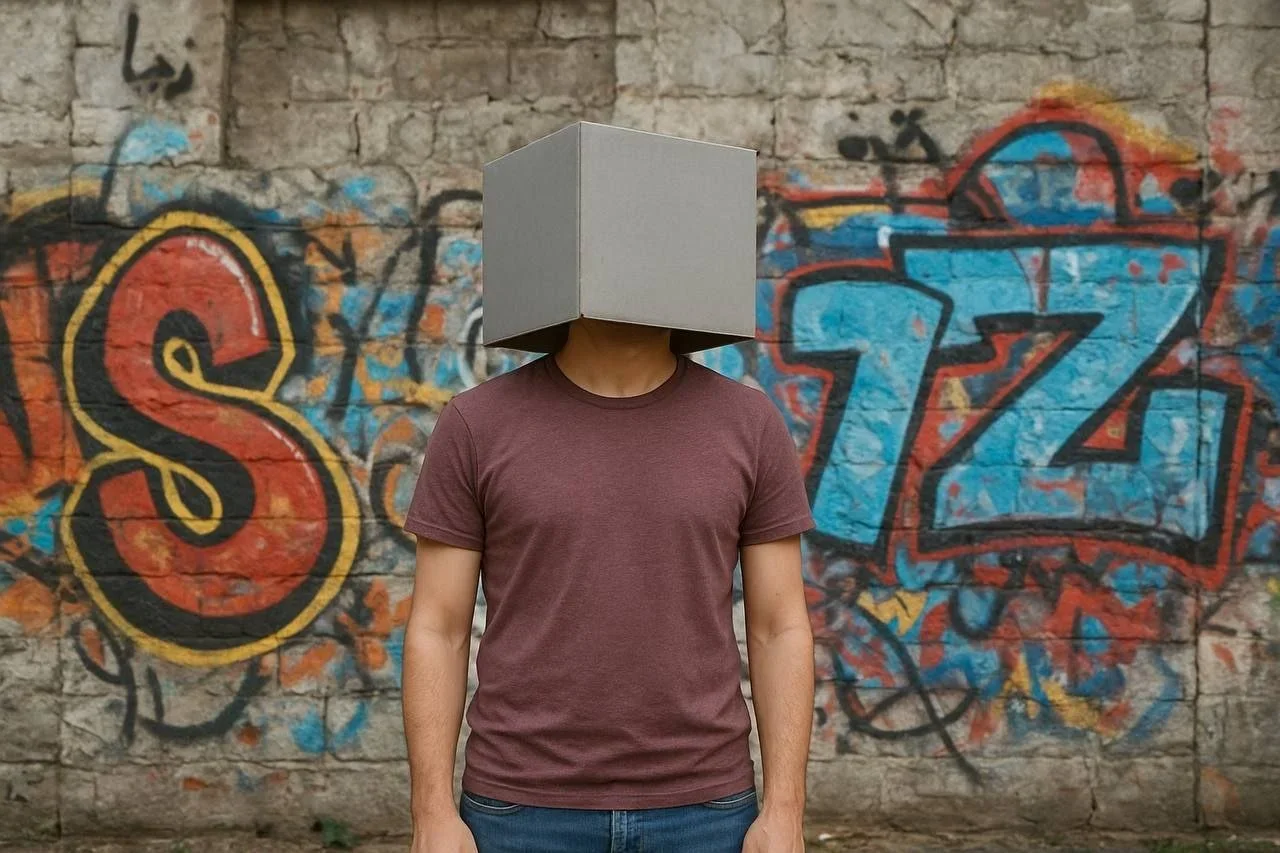10 Questions with Doug Winter
Al-Tiba9 Art Magazine ISSUE19 | Featured Artist
Doug Winter is a semi-sighted North American conceptual photographic artist and filmmaker whose artworks focus on the preoccupation of light and non-figurative forms. Doug's non-representational photographs of conventional objects and their environments are derived from the human body's resilience to adapt and accommodate a physical disability and emotional trauma.
Doug Winter - Portrait
ARTIST STATEMENT
Photography is widely regarded as a truthful medium, and Doug Winter's images honour the diversity of personal truths. Winter's work expands the traditional approach to photography by using the camera as a conceptual mechanism to investigate how the human system adjusts, grieves, and adapts to trauma and physical impairment. He utilises analogue photo-mechanical methods to create photographs that expose latent memories through non-representational forms, text, and colours. Each image serves as an organised impression of memories and sensations, connecting the spectator to their life experiences.
Every Ribbon Cuts a Circle, Day 5, Varnished Archival Inkjet Print on Cotton Rag Paper, 63.5x101.6 cm, 2023 © Doug Winter
Unfolding | Project Statement
This body of work explores how visual impairment reshapes not only how we see, but how we remember, grieve, and hold on. After a retinal stroke altered his vision, the camera became a conceptual tool for Doug Winter: not to capture and preserve clarity, but to explore the instability and preciousness of the human senses we so often take for granted. He began physically altering lenses and working directly on the camera’s digital sensor to reflect what his eyes could no longer stabilise, introducing fracture, softness, unreliable shapes, and imprecision as a way to investigate how memory and sensory experience intertwine. Each piece is rooted in the body’s way of knowing, how memory is carried not just through sight, but through touch, pressure, and sound. When vision falters, other senses rise to fill the gaps. A tone of voice becomes a landmark. The texture and colour of a curtain, the warmth of a surface, the rhythm of someone breathing beside you, these become part of a personal archive. One that draws conclusions, attempts reason, and helps protect from fear or harm, even when the mind can’t name it directly.
Twin Hearts, Day 131 (in two parts), Varnished Archival Inkjet Print on Cotton Rag Paper, 91.4x61 cm, 2024 © Doug Winter
AL-TIBA9 ART MAGAZINE ISSUE19
Get your limited edition copy now
INTERVIEW
Welcome back to Al-Tiba9. What have you been up to since we last featured you?
My practice has deepened and expanded in ways I couldn't have anticipated.`My work was embraced by curators in Mexico City, which led to invitations to both group and solo exhibitions. While there, I was also invited to participate in a monoprinting workshop, an experience that reshaped both my thinking and my practice. I fell in love with the press and began integrating monoprint techniques into my photographic process, opening up new visual ground and allowing me to expand my conceptual ideas further.
In 2023, I was honoured to receive a National Endowment for the Arts grant through the Seeding Creativity program in Sacramento County, which supported a major solo exhibition of my work. I also began teaching photographic arts at two community colleges, a rewarding extension of my practice.
Last year, I was awarded a fully funded artist residency at the Hong Museum in Shanghai, China, through the Arte Laguna Prize in Venice, Italy. I'll spend six weeks this fall developing new work in Shanghai. Currently, I'm an artist-in-residence at the KALA Art Institute in Berkeley, California, continuing to explore tactile materials, alternative printmaking methods, and new ways of working with visual impairment as both limitation and conceptual framework.
How has your creative process evolved, both technically and emotionally, in the past few years? Do you find your practice has shifted in any way?
While working on my National Endowment for the Arts grant exhibition, I began asking myself deeply personal questions. Instead of trying to control my actions, the camera's actions, and the outcome, I committed to investigating them, no matter the emotional or mental cost. Something broke open during that process. The barriers I had once associated with photography, the rules I was taught and had followed for decades, began to fall away, tearing down the foundation I had built my practice on. That intense emotional experience pushed me away from my photographic roots and into unknown areas of both my life and my art. I stopped using the camera as a tool of documentation and began using it as a conceptual mechanism, something capable of holding uncertainty, ambiguity, and contradiction.
After the exhibition closed, I reread my notes and revisited the responses people had shared with me, at the opening, in writing, and through the sale of the work. I felt a deep satisfaction at having completed something so meaningful and memorable. But I also felt an unexpected emptiness.
I applied to and was accepted into the artist-in-residence program at KALA. Working long hours in that space, surrounded by tactile materials and other artists, shifted everything again. I gave myself permission to create without second-guessing.
I began pursuing long-buried memories, especially those tied to visual impairment, grief, fragmented recall, and traumatic sensory experiences. The work became more vulnerable, more embodied. In some cases, it became too personal to ever show publicly, not because the work failed, but because it did what it needed to do. It was for me. And I'm proud of the vulnerability and courage it took to name the past, witness it, and let it go.
Hold Still, Varnished Archival Inkjet Print on Cotton Rag Paper, 91.4x61 cm, 2024 © Doug Winter
Unidentified Witness, Varnished Archival Inkjet Print on Cotton Rag Paper, 91.4x61 cm, 2025 © Doug Winter
Speaking of new works, you recently launched a new series, Unfolding. Can you walk us through how this series came to life, from concept to final image?
The series is deeply rooted in sensory memory and non-visual perception, as you mention in your statement. Can photography, traditionally a visual medium, adequately evoke these non-visual sensations? How do you attempt that in your work? That's the core tension I'm working with, how to use a visual medium to speak to non-visual experiences. Photography is traditionally tied to sight, clarity, and documentation as a way to prove evidence. But for me, it's become a way to explore what lies beneath. I'm interested in what happens when we remove the expectation of sharpness or evidentiary clarity, when we let photographs behave more like sensations than appropriated representations.
The series is deeply rooted in sensory memory and non-visual perception, as you mention in your statement. Can photography, traditionally a visual medium, adequately evoke these non-visual sensations? How do you attempt that in your work?
That's the core tension I'm working with, how to use a visual medium to speak to non-visual experience. Photography, traditionally tied to sight, clarity, and documentation to prove evidence. But for me, it's become a way to explore everything. I'm interested in what lies beneath, what happens when we remove the expectations of sharpness or clarity of documentation, when we let photographs behave more like sensations than appropriated representations.
To do that, I disrupt the mechanics of the camera itself. I alter lenses, impair sensors, and allow the camera to react without my implicit control, so that the resulting image carries the feeling of instability or fracture. These choices can mirror my own visual impairment, but they also speak to how we feel and retain our memories: through tone, pressure, warmth, or even sound. I often think of my images as emotional or sensory echoes, like the warmth left in a bed after someone gets up.
So no, photography might not traditionally be designed to hold non-visual sensation, but that's precisely why I'm drawn to pushing it. The medium's limitations become part of the conceptual framework. In embracing and exploiting its failures and limitations, I've found an opening for something deeper and more embodied to occur.
Veiled Sight, Day 75 (in two parts), Corazones Gemelos, Día 131 (en dos partes), Varnished Archival Inkjet Print on Cotton Rag Paper 101.6x152.4 cm, 2024 © Doug Winter
In Unfolding, you describe working directly on the camera's digital sensor and altering lenses. What led you to those experimental techniques, and how do they align with your practice?
What led me to alter lenses and work directly on the sensor began with looking at a scan of my own eye, at my impairment, and continued through a series of conversations with mentors and peers during the development of my NEA exhibition. I completely released the constrictive rules of traditional photography, the preciousness of the sensor, the perfection of optics, and allowed the camera itself to take on an impairment much like my own.
I realised that traditional photography, and traditional sight, no longer reflected how I experience the world or how I retain memory. So I used that feeling and experience to exploit and uncover what lies beneath, to let the image emerge not from control, but from disruption, sensation, and the instability of perception itself.
The idea of "truth" in photography is central to your practice. How has your understanding of visual truth changed as your work became increasingly abstract and sensory-driven?
Photography is often regarded as a truthful medium, but truth itself is an abstraction. My work moves from objective truth toward the subjective. The images I create honour the diversity of personal truths while also acknowledging that truth is never fixed. My memory of an event may be entirely unrecognisable to someone else who experienced it, shaped by age, height, gender, emotion, trauma, or cultural bias. If I have tears in my eyes during a traumatic moment, what I see becomes distorted, filtered through grief or pain. That vision is abstract, yet it's still part of my truth. So I ask: how does a memory remain truthful when the visual itself is altered?
I think of truth as a kind of Venn diagram, overlapping perceptions, with a residue of shared experience in the middle.After the moment passes, something remains, like the traditional film photographic process itself: a latent image, invisible but present, waiting for the right conditions to emerge. That's what I'm working with, the possibility of truth, even when it's fractured, uncertain, or incomplete.
Snow Day No. 8 © Doug Winter
Full of Grace - Ditych © Doug Winter
Has your relationship with memory or grief changed while creating Unfolding? Did the process bring unexpected revelations or moments of discovery?
Grief is love without a home, and that's a confusing place to live. The grief I carry daily can be overwhelming. I often question why my life has followed this path. I'm so thankful and lucky for the life I have been given, but I often ask why I've experienced such pain, why some memories are colored in such unsettling ways.
Creating Unfolding changed my relationship with memory and grief in ways I never expected. I dove deep into autobiographical experiences, many filled with confusion and pain, others marked by joy and adulation. I confronted the honesty I held to those memories and examined my own role in them, how I showed up, what I carried, what I avoided. That process lifted a veil. I finally began to understand why I gravitate toward specific experiences, why I react the way I do. And what's been most challenging to accept is this: my art practice has become a kind of transparency, a way to physically manifest grief and memory. I can now hold it in my hands. I can tear it apart. Or I can hold it and cry. This time, it's deeply personal. Many of the new pieces will never be shown publicly, not because the work isn't successful, but because it's too raw. Too close. Unfolding has made me take inventory: Where am I? What was my role, good or bad, villain or hero, within a life marked by brutality, beauty, and sometimes madness, all entangled in the lives I've shared or passed by on the street?
Are you exploring new materials or mediums beyond photography in your current or upcoming projects, perhaps more tactile or sound-based work?
Yes, I am exploring new materials and mediums beyond traditional photography. Though the work remains grounded in light and image, it is now pushed further into themes of extended time (memory), material failure, and both physical and emotional residue.
For my NEA exhibition, I created two tactile-based pieces. One, titled Blue #3, invited guests to touch and reflect on the colour blue as both a visual and emotional experience. The second, Flames of Cantania, was a collaborative, photographic, and text-based artwork in which guests physically helped reveal hidden elements, connecting interaction with meaning and personal memory.
At KALA, I've been focused on gradually removing the image from photo-based works, leaving behind only the emotional trace or memory of what was once there. It's an ongoing process of visual, tactile, and emotional problem-solving, deeply personal, challenging, and extremely rewarding.
I've also begun experimenting with sound, shadow, and experimental film. I'm currently in the early stages of principal photography for this new work. It's not yet ready to share. I hope to present it in a solo exhibition in late 2026.
North East Day 3 © Doug Winter
How do you envision your next body of work developing? Are there new themes or personal experiences you're beginning to explore artistically?
My next body of work is developing slowly, but with intention. Much of it is rooted in the themes I've already begun to explore, memory, autobiographical experiences, impermanence, and the instability of perception, but I'm now leaning further into absence. I'm focusing on experiences and sensations that have lingered unresolved or unnamed, especially those tied to vulnerability, masculinity, and physical limitation.
The work is becoming less about what is shown and more about what is felt, remembered, or sensed at the edge of recognition. That's the direction I'm headed: toward work that doesn't explain, but invites, quietly, and sometimes uneasily, what lives beneath the surface.
Looking ahead, what does artistic success look like to you now? Has that definition shifted since your early career? And what would you like to achieve in the next 5 years?
Artistic success looks very different to me now than it did at the start of my career, it's less about recognition and more about honesty, endurance, and the depth of connection my work can create. Success now means making work that's emotionally resonant and deeply connected to my lived experience, creating from a place of vulnerability and reflection. It's not just about showing something, but about feeling it, allowing it to speak universally in ways that go beyond surface or explanation. In the next five years, I plan to seek targeted grant funding and pursue public art opportunities. I want to deepen my exploration of experimental film, sound, monoprinting, and tactile installation, pushing further into abstraction and non-visual perception. I hope to create immersive work that resonates across sensory and cognitive differences, and connect with artists navigating disability, grief, or fragmented memory. For me, success now means staying close to what's real, even when it's hard to name.
Artist’s Talk
Al-Tiba9 Interviews is a curated promotional platform that offers artists the opportunity to articulate their vision and engage with our diverse international readership through insightful, published dialogues. Conducted by Mohamed Benhadj, founder and curator of Al-Tiba9, these interviews spotlight the artists’ creative journeys and introduce their work to the global contemporary art scene.
Through our extensive network of museums, galleries, art professionals, collectors, and art enthusiasts worldwide, Al-Tiba9 Interviews provides a meaningful stage for artists to expand their reach and strengthen their presence in the international art discourse.


























